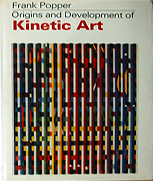
From Technological to Virtual Art
Frank Popper
MIT Press, 2005
504 pages
ISBN: 026216230X
Will be published July 2005 ... awaited with excitement. August. Still not published. November ... it will be nothing this year ... (one year later.) October 02006 ... and it still isn't out. February 2007 I have it in my hands ... now i only need time to read it. June 2008 ... here we go.
From the Introduction:
"This book is based on three ideas. The first concerns the hypothesis that contemporary virtual art can be considered a new and refined version of technological art [...]. As such, virtual art represents a new departure - new in terms of its humanisation of technology, its emphasis on interactivity, its philosophical attitude towards the real and the virtual, and its multisensorial outlook.
The second idea posits that the artists practising virtual art, although having quite a few traits in common with more traditional artists, distinguish themselves from them in may ways, especially through their techno-aesthetic creative commitment. Presumably, some of these characteristic features can already be found in a number of early-twentieth-century forerunners.
Third, I think that virtual artists generally pursue - apart from, or rather linked with, aesthetic finalities - a certain number of extra-artistic goals that appear to be of a scientific or social order, but that are in fact also concerned with basic human needs and drives"
|






